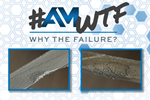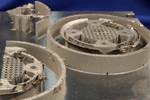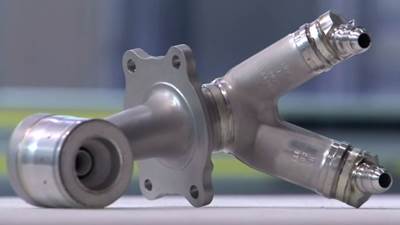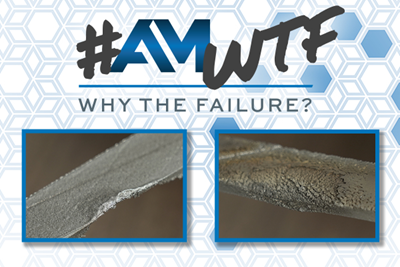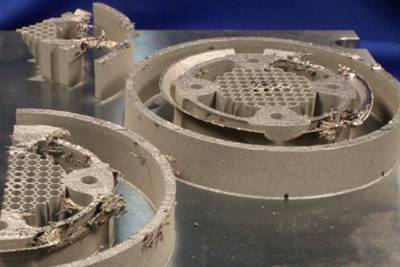One pattern I have noted in visiting and meeting with companies succeeding with additive manufacturing (AM) is the way that innovators in AM — the ones farthest along with realizing its promise for part production — also tend to be guarded or gloomy in discussing that very promise. Are advances in additive being led by curmudgeons?
In this episode of the AM Radio podcast, I put that question to Stephanie Hendrixson, and in our discussion we find our way to what I think is the explanation for this phenomenon. Find the episode in your podcast app, listen here using the player above, or read on for a transcript.
Transcript
Stephanie Hendrixson
Welcome to AM Radio, the show where we tune in to what's really happening in additive manufacturing. I'm Stephanie Hendrixson. In today's show I talk with Pete Zelinski about why the people who know additive manufacturing the best tend to be the most negative about it. Then we switch gears and I challenged him to explain why in spite of all the difficulties, there is still reason for optimism in additive manufacturing. That's coming up on AM Radio.
The AM Radio podcast is brought to you by the Additive Manufacturing Conference and Expo, the leading industry event focused on 3D printing for production. Plan to join us October 12 through 14th at the Duke Energy Center in Cincinnati, Ohio. Learn more at AdditiveConference.com.
Peter Zelinski
Stephanie, there's this phenomenon that I think I've noticed that I want to lay out and see what you think of this. I've noticed the way that the people who are succeeding with additive manufacturing also tend to be kind of curmudgeonly about additive manufacturing.
Stephanie Hendrixson
Yeah, I've kind of noticed that too. It's, it's this complicated technology. And it seems like if you really get to understand it and know about it, you do kind of come off as a curmudgeon because you're, you're, you know the reality behind it.
Peter Zelinski
So let's try to talk this out. Let's try to like why is it people who are good at additive can be Debbie Downers about additive. Like and so so, I first I guess I first noticed this, and I didn't really notice it as a development or a trend at the time. But I first noticed this years years years ago, I was the first time I was talking to the people at GE Aviation in around 2013, maybe, who were working on the fuel nozzle at the time, and they were working with what was then Morris Technologies at the time to develop this part. And I was there in a meeting with them. And we had launched this publication the version of it, we had back then, Additive Manufacturing, and I was there to report on this and talk about and I talked to them about, we're speaking to manufacturers about the possibilities of additive for functional parts for end use part production. And the GE Aviation people at the table with me heard that and kind of looked at me and said, like, good luck. And they sort of went into all the struggles they're having about additive that we're making them yeah curmudgeonly about the hope and promise and possibilities of additive.
Stephanie Hendrixson
So even as they're they're working on this fuel nozzle, like the golden child, part of additive manufacturing, like they're having this experience of feeling kind of pessimistic about what they're doing and how difficult it is and how it's going.
Peter Zelinski
Pessimistic’s, maybe the right word, or maybe not. Or maybe it's there at that time, they were struggling with whether they could really pull it off. And that goes back a-ways. But I think we keep on encountering the same thing. The same thing right here and now in the companies that have taken additive much farther. And so let's talk about this. But let's try not to name names or any identifying details, because because we admire these people. And I don't want to call anyone a curmudgeon. But talking to for example, a company that is succeeding very well with making aircraft related parts, high quality parts through additive production, talking to the leadership of that company, and hearing them sort of have a Whoa, whoa, whoa, response to the promise of additive where it can succeed and where it may be can't succeed. The sort of putting bounds on the role it might play and how fast it might progress that was that was metal components. But I'm now I'm thinking right away of also like a, a company making production scale polymer parts and it's much the same thing like they've, they've actually figured out how to succeed. But they're also very sanguine about how far we can go in extrapolating what that success might mean.
Stephanie Hendrixson
And so both of these are cases of companies that are doing production work through additive manufacturing, right. And they're doing it at for aerospace. So at a pretty high level. And they still kind of have that same demeanor as companies that are maybe just starting out and facing the difficulties.
Peter Zelinski
Yeah, yeah. And so and so I think about like why that is because any each of these examples I'm thinking of they have no reason to doubt their own success or doubt that they're successful go far there. Because they are realizing the possibilities of additive manufacturing, and how it can change what's possible in production and, and for their customers delivering real wins.
Stephanie Hendrixson
So it's interesting that you, you mentioned the customers, because I'm sitting here listening to these stories and like, that's kind of where my mind goes. I feel like when I have encountered the additive manufacturing curmudgeons, a lot of times, they're curmudgeonly because of the relationship to the customer. Customers maybe don't exactly care whether their part is 3D printed, or made conventionally, but when it is 3D printed, and maybe they end up having unrealistic expectations about how long it's going to take, what it's going to cost, the type of complexity and the type of geometries that are that are viable. And so I feel like this comes up in conversation a lot with people who are customer facing, who have just struggled over and over to explain to an external buyer, you know, why they can't get their part the next day, or these other challenges, and that tends to kind of, I don't know, bring down their optimism a little bit about it.
Peter Zelinski
I totally think you're onto something there. And I think that explains a big part of this phenomenon that to succeed at additive manufacturing, is to draw more attention to that success. And you find yourselves more and more frequently in conversation with customers, and even more so with prospective customers who come to you with, with vastly exaggerated senses of what additive can do right now. And, it's of the form, take this part that I'm already producing some conventional way, and just make it through 3D printing, and it'll be cheaper, faster, better. And it might be taking an existing part, it might be none of those things, if you make it through 3D printing, and yeah, the lead time thing. So the lead times for introducing a new product, if additive manufacturing is your production process, can be vastly, vastly shorter. The entire development and into production cycle can be tremendously accelerated. But yeah, you can't just hit print and get your part tomorrow; it's not that fast. But you have to be in additive, to be in this space, to be confronted with all these all these manufacturers, all these OEMs who understand the truth, partially, but then also have some some mythology mixed in with what they understand. Yeah, you have to sort of develop a demeanor of cold water just to sort of get get the get the get yourself to the realistic expectations, and the realistic winds for 3D printing of which there are many.
Stephanie Hendrixson
Yeah, I mean, how many times have we heard somebody say like, that they are in a position of educating their customers, they have to explain the technology, they have to explain the capabilities. And yeah, there is like that mythology mixed into it and a starting point for an OEM or somebody that's going to a supplier to get 3D printed parts as they just have to be speaking the same language. And sometimes, the language kind of starts in that that sort of negative space and it can come across as it can come across as curmudgeonly, just like we said at the beginning of this,
Peter Zelinski
Yeah, yeah, tempering expectations. And then I actually think there's this whole other avenue to this too. And it it, it probably gets back to that initial experience years and years ago, talking to the GE Aviation people, which is to succeed it additive. Again, it's not just hit print, there's all these in the weeds details that have to be worked out. And initial failure can be part of the process. And and getting the postprocessing steps just right can be part of can be part of process development. And all of that has to be worked out. And all of that is part of process development. And any part made in any fashion is going to entail process development. But if you're only a little aware of additive manufacturing, you could come to it with an unrealistic sense of how easy it is. And so not only tempering expectations about added what additive can do, but also stealing yourself for the fact that process development might be this unpredictable course of finding your way through weeds after week after week after week in the weeds until you get the process nailed down. Like that's yes, I'm curmudgeonly, is a very reasonable response to that reality as well.
Stephanie Hendrixson
Yeah, so maybe just as a way to kind of wrap this up, what is your reaction? What is your response when you encounter in additive manufacturing curmudgeon?
Peter Zelinski
So for one, I guess I recognize it and I recognize where that comes from. And I think I'll turn that question around. What is my response now when I encounter and over the moon additive manufacturing enthusiast, I think you and I are streetwise enough now that a little bit of a red flag goes up there like I feel like if you are too sunshiny about additive manufacturing maybe you're not really doing it.
Stephanie Hendrixson
I think that's well said. There’s some trust that comes out of the curmudgeonly demeanor and you know, if someone is not over the moon about additive, I tend to assume like they must just be very realistic about the challenges and the opportunities there.
Peter Zelinski
Yep, respect for curmudgeons.
Stephanie Hendrixson
Alright, that's it for this half of the show. We'll be right back after this.
The AM Radio podcast is brought to you by the Additive Manufacturing Conference and Expo. The leading industry event focused on 3D printing for production. The conference takes a practical applications-based look at the machines, materials and methodologies being used to create and use tools and components. The event is designed for owners, executives and engineers in manufacturing as well as OEMs. involved in durable goods production. Join the additive manufacturing team in Cincinnati, Ohio for two days of in-depth conference sessions, exhibits and plenty of networking opportunities with am experts. Also on the expo floor, check out the finalist entries in the cool part showcase a contest to find the next subject of our video series. The cool part show, be sure to vote on your favorite. The Additive Manufacturing Conference and Expo runs October 12 through 14. Find all the details and register at AdditiveConference.com.
Okay, Pete. So we just had this whole conversation about realism and skepticism in additive manufacturing. But now I want to talk about optimism, because I've heard you say in different contexts, things like you believe in additive manufacturing. additive is the way forward for manufacturing. And I want to just kind of like get to the bottom of that. And why are you so optimistic. So I guess as a starting point, like you've spent most of your career as an editor of our sister publication, Modern Machine Shop, which is all about machining — subtractive manufacturing. And I want to start by just asking you like what was the experience or the moment that convinced you that additive manufacturing is for real?
Peter Zelinski
The moment boy, I don't know if there was a moment I feel like it's been sort of an a gradual process of figuring this stuff out. And I think I'm still doing that. And I think I'm still revising the picture. But if I'm going to point to one moment early on, it was CNA tool is this is this very successful machining business in northern Indiana. Churubusco, Indiana, and it's founded by this guy, Dick Conrow, who, who we just recently lost, he passed away maybe a year ago. But over the course of decades, he built up this very sophisticated, as I say, very successful CNC machining business. And he got into additive, to metal additive manufacturing, and I was visiting that facility to see the additive equipment. Let's say it was 2014. I might be getting that year wrong by one, but somewhere around then. And at that time, we were still wrestling with questions of what is really the place of 3D printing? Is it is it really just for prototypes, and one-offs and maybe some tooling? And there were plenty who were who were seeing a production role for it. And Dick Conrow was one who was seeing the production role, to the extent where he was using these EOS laser powder bed fusion machines. He had four of them I think at the time and was using them for nothing but production parts and just to end seeing him in his facility, seeing the parts he was producing for customers. And he was just thinking about this technology in an industrial way, in a production way. That that for someone who understood production and metalworking so well that it fit that model that he lived in mastered so well. I think I just saw it there and so some of the stuff he was wrestling with at that time uninterrupted power. He was he experienced the problem with that real time a lightning storm came in and ruined a job and like for a moment there his people turned into farmers they were like watching the horizon looking for rain showers to come before they had solved the power supply problem, something additive manufacturing they take for granted. And brackets. Dick Conrow was the first one who said to me, Pete, you know what, what this technology really wants to make? It wants to make brackets. And he explained all that to me and like how much do we love brackets?
Stephanie Hendrixson
So much. So okay, so this was kind of an early experience like 2014, thereabouts, like that's before I started writing for additive and to have a company out there that's doing metal production and dedicating machines to that, that is pretty unique for that time. And you sort of started describing some of the challenges that they were facing on interrupted power. We've talked about a lot of the other difficulties with additive. And I'm wondering, you know, if additive is so difficult to implement, and to get it right, like why is it still worth doing?
Peter Zelinski
I mean, what's not difficult to implement? I mean, life is hard, who hasn't noticed that? But why is it worth it? additive manufacturing's cost saving potential is so transformative. But you have to transform yourself to get there. And those kind of cost savings have to do with this. This more nimble, less hardware dependent, less inventory dependent, less advanced warning dependent way of producing that is vastly different from the way we organize production right now, and vastly liberating relative to all of the burdens and constraints that we take for granted in manufacturing now. And we're walking forward into this process of figuring out what kind of parts are possible in this new mode of production, and then the kinds of things we can do with it. And it's so promising that, like, I think the adventure is just beginning. Like that's why it's worth it that that adventure of finding out the new stuff we can invent and the new stuff we can produce.
Stephanie Hendrixson
So the adventure of finding out, I guess that's something I'm curious about, like this is a topic that we as the additive manufacturing brand have been covering for almost 10 years now. And production has certainly grown in that time production using additive manufacturing. But I'm wondering what are the hurdles that we're still trying to overcome? What are the reasons that people aren't adopting additive, and we're sort of getting there but I want to hear you kind of elaborate on that.
Peter Zelinski
So I heard this analogy once that's in a different, entirely different place. And it has to do with installing high-speed data cables, within neighborhoods, with connecting houses. And the and the analogy is the last mile problem. What you need to do to set up the network, it's pretty straightforward, broadly speaking, but then what you need to do to connect every individual house like that's where the difficulty really comes. And so part of it is, the obstacles you're describing part of it is that last mile problem in manufacturing. The additive capability is there. It is repeatable and resilient. And it can give us the products and properties that we want and almost any application we want to apply it to. But how do you make it work within the particular application that you want to master it in? And how do you convince all the stakeholders within that application that it does work, and it's giving you the product that everybody wants, and these are the kinds of challenges that are kind of knotty in the details and we're still working out and will take a while to work out. The other challenge is that the existing conventional manufacturing processes work pretty good, and work downright well for what they're trying to do for what we've asked them to do over the course of all these years. And it is pretty difficult and pretty expensive to run your established process at full output. And at the meantime, invent the future in parallel by running a different process that asks for different organization and almost a different structure of the enterprise. Yeah, in parallel with that. So in some ways the success of our existing current processes is a competitor. And it has a slowing effect on the adoption of additive.
Stephanie Hendrixson
Right. So getting past those incumbent processes and finding the pathway forward for additive is something that we're working through. I guess what I, what I haven't heard you say yet is like the real potential here for additive. Like go big picture. Why should companies make the investment in figuring this pivot out?
Peter Zelinski
We take for granted in industry today, that design engineering is one thing. And manufacturing, engineering is another thing, and even marketing and aftermarket support are other things all together. And what if there is a different way of thinking about production, and invention, and the enterprise in which all those things bleed together, and all of those things are nimble. And all of those things are happening at the same time and continuing to happen at the same time, all while the product is, is in the field and finding its customers. And what I mean by that is, it's no longer going to be necessary to lock in your design, at some point, have the design engineers all let go so that manufacturing can take over because tooling requires your design to be to be fixed and stable. What about a process and this is something I think we'll take for granted in the future. The product continues to get better as it's used in the field in the same way that our software we take for granted continues to get better as people use it in the field, keep on changing the design, because designs don't have to be fixed. And what we consider the cost of inventory today and logistics today. And preparing for aftermarket service today. What if all of those shelves full of stuff could be barren and all those warehouses didn't have to be filled and didn't have to take up space. Because we can print fast enough and print near enough to where the end use might be that we can create all these objects as they're needed and wait until the world gives us cues for what's needed and make them then all this stuff is strange. But it's a really powerful and really efficient. And both economically and resource conserving way to produce that is that is vastly different than what's possible for us now. To live and move and build your career and build your business in industry and manufacturing right now is to take a lot of burdens for granted. And all these burdens can be shed once additive manufacturing is adopted a lot more and gets a little better.
Stephanie Hendrixson
So lots of reasons for optimism in there. So I guess maybe as just kind of a wrap-up, last question here. Given everything that we've talked about today, the pessimism and the optimism, what advice would you give to manufacturers who are looking to adopt additive and to get into additive manufacturing?
Peter Zelinski
I will give you the answer that you expect and everyone says and then I'll give you a different answer that maybe we haven't heard before. So the answer everyone says, because it's true, is get some 3D printing capability and use it for your own internal needs, make tools with it. Make stuff that you can use around the facility with it. Tooling in particular. These are, these are parts, these are functional parts. And just the exercise of making tools, noncritical parts that customers don't have to see is going to teach the organization a whole lot about what additive can do and begin that process of unlearning design constraints and and beginning to to get engineers minds moving around within the freer and more open design space that additive permits.
The other advice I would give recognizes that within additive manufacturing, there is a big advantage to new entrants. New products that have never been made before have an advantage because there's no existing manufacturing process that has to be adapted or pivoted. And new companies coming into manufacturing have an advantage. Companies that have never done manufacturing before actually have an edge in additive manufacturing because they're not burdened say with an ongoing process that's also working well but they also have to support and that shapes the culture of the enterprise and the organization and the process. So the advice I would give is do you see a way? Do you see an opportunity to give yourself something like that new entrant edge, if there's a new product coming along an entirely new product addition for the company, a new addition, is there a way to produce that through 3D printing or with 3D printing bring significant advantages to that to that product? And if there is a way, lean hard into that and make it a 3D printed product, and pretend that your other processes don't exist. You'll need those other processes, but pretend they don't exist and require engineering to go seek them out as a newcomer would, and then turn the team around that product into a new entrant team as well try to do that. Put them into a space capsule somehow isolate them from the rest of the organization, not because the rest of the organization can't teach them something they absolutely can. But additive manufacturing requires a different organization and a different culture and deal with that and do everything that has to be done to deal with that let the team feel a sense of distance and mission and specialists and cohesion the way a group of new entrants would, because otherwise, the pull of gravity and inertia of the strength and establishment of the existing organization is going to impede what you're trying to do with additive manufacturing. So yes, send it out into a space capsule, send it out into a boat, let it make the new product that way, and then bring it back in when it starts to succeed.
Stephanie Hendrixson
Yeah, so it's almost getting back to that like skunkworks idea where you have facility within a facility or group within a group.
Peter Zelinski
The skunkworks idea, totally. I guess I like my spacecraft imagery a little better. But totally.
Stephanie Hendrixson
I mean, we can, we can stick with that we'll end with that. And Pete, is there any anywhere that you'd like to direct our listeners to learn more information?
Peter Zelinski
You've hinted at a couple things we've posted on AdditiveManufacturing.Media. I posted a commentary recently about reasons why I'm bullish about additive, it sort of gets into the obstacles at this point are largely numbers. And that argument might be interesting to people who are thinking about causes for optimism and additive manufacturing are younger people who are maybe thinking about where their career should go with it industry or within manufacturing. Oh, you know where else they could go is there was that piece that we published a while ago, a long piece, it's called “What Your CEO Should Know.” And it's about ways the enterprise, the whole enterprise, not just manufacturing, needs to change to make good use of additive manufacturing. And that's a that's a piece we keep on recommending to companies that are struggling with this particularly larger companies thinking about how to think about additive manufacturing.
Stephanie Hendrixson
Yeah, that's a really good resource and we'll put links to both of those in the show notes. I think that's it for today's show.
AM Radio is recorded with help from Austin Grogan and Kade Nicholson. The show is edited by me Stephanie Hendrixson, along with Alex Lytle, and Troy Brewer. Our artwork is by Kate Billberry. AM Radio and Additive Manufacturing Media are products of Gardner Business Media located in the Queen City, Cincinnati, Ohio. I'm Stephanie Hendrixson. Thanks for listening
Related Content
This Drone Bird with 3D Printed Parts Mimics a Peregrine Falcon: The Cool Parts Show #66
The Drone Bird Company has developed aircraft that mimic birds of prey to scare off problem birds. The drones feature 3D printed fuselages made by Parts on Demand from ALM materials.
Read MoreVideo: 5" Diameter Navy Artillery Rounds Made Through Robot Directed Energy Deposition (DED) Instead of Forging
Big Metal Additive conceives additive manufacturing production factory making hundreds of Navy projectile housings per day.
Read MoreHow Machining Makes AM Successful for Innovative 3D Manufacturing
Connections between metal 3D printing and CNC machining serve the Indiana manufacturer in many ways. One connection is customer conversations that resemble a machining job shop. Here is a look at a small company that has advanced quickly to become a thriving additive manufacturing part producer.
Read MoreHow Norsk Titanium Is Scaling Up AM Production — and Employment — in New York State
New opportunities for part production via the company’s forging-like additive process are coming from the aerospace industry as well as a different sector, the semiconductor industry.
Read MoreRead Next
Video: The Additive Nozzle’s Origin Story
The LEAP engine fuel nozzle is likely additive’s greatest success in part production so far, but it wasn’t always clear that the nozzle could be made this way. This video from GE Aviation tells the story.
Read MoreMetal 3D Printed Part Should Be Flat, Has Bubble — AM: Why the Failure? #1
What should have been a straightforward application of laser powder bed fusion to make a simple component in 316L stainless steel turned into a printing fail. See why the failure happened.
Read MoreThe Harsh Realities of Additive Manufacturing
Now is the time to start talking about what is really holding back additive manufacturing.
Read More



